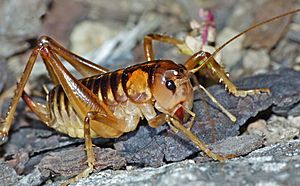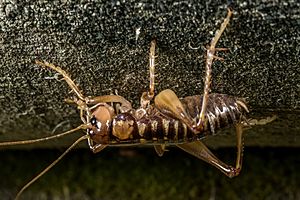Otago ground wētā facts for kids
Quick facts for kids Otago ground wētā |
|
|---|---|
 |
|
| Scientific classification | |
| Genus: |
Hemiandrus
|
| Species: |
maia
|
The Hemiandrus maia, also known as the Otago ground wētā, is a special type of ground wētā. It lives only in New Zealand. These wētā are active at night, so during the day, they usually hide in burrows underground. You can find them on the South Island of New Zealand. Scientists say this species is "not threatened," which is good news! What makes this wētā really unique is that the female takes care of her eggs and young. This special behavior is called maternal care.
Contents
What is the Otago Ground Wētā?
The Hemiandrus maia was officially named in 2013. Before that, people knew it by a different informal name. The name "maia" comes from an old Greek word meaning 'mother' or 'good mother'. This name was chosen because the female wētā are excellent mothers to their young.
Where Do Otago Ground Wētā Live?
The Otago ground wētā is a native animal of the South Island in New Zealand. Since they are "ground wētā," they spend their days hidden in burrows underground. They are nocturnal, meaning they come out at night. When it's dark, they are busy moving around on the ground. You might also spot them climbing on plants and other vegetation.
How Are Otago Ground Wētā Protected?
The New Zealand Department of Conservation keeps an eye on many native animals. In 2014, they officially said that the Otago ground wētā is "not threatened." This means they are not currently at risk of disappearing.
What Do Otago Ground Wētā Eat?
Otago ground wētā are omnivores. This means they eat both plants and other small animals. Their diet includes fruits and small invertebrates (like insects). However, they do not eat the seeds of native plants.
How Do Otago Ground Wētā Behave?
These wētā don't come out of their burrows every night. On average, they emerge about once every three nights. A very interesting behavior is that female Otago ground wētā often share burrows. They work together to care for their eggs and young nymphs. This shared maternal care is quite special among insects.


